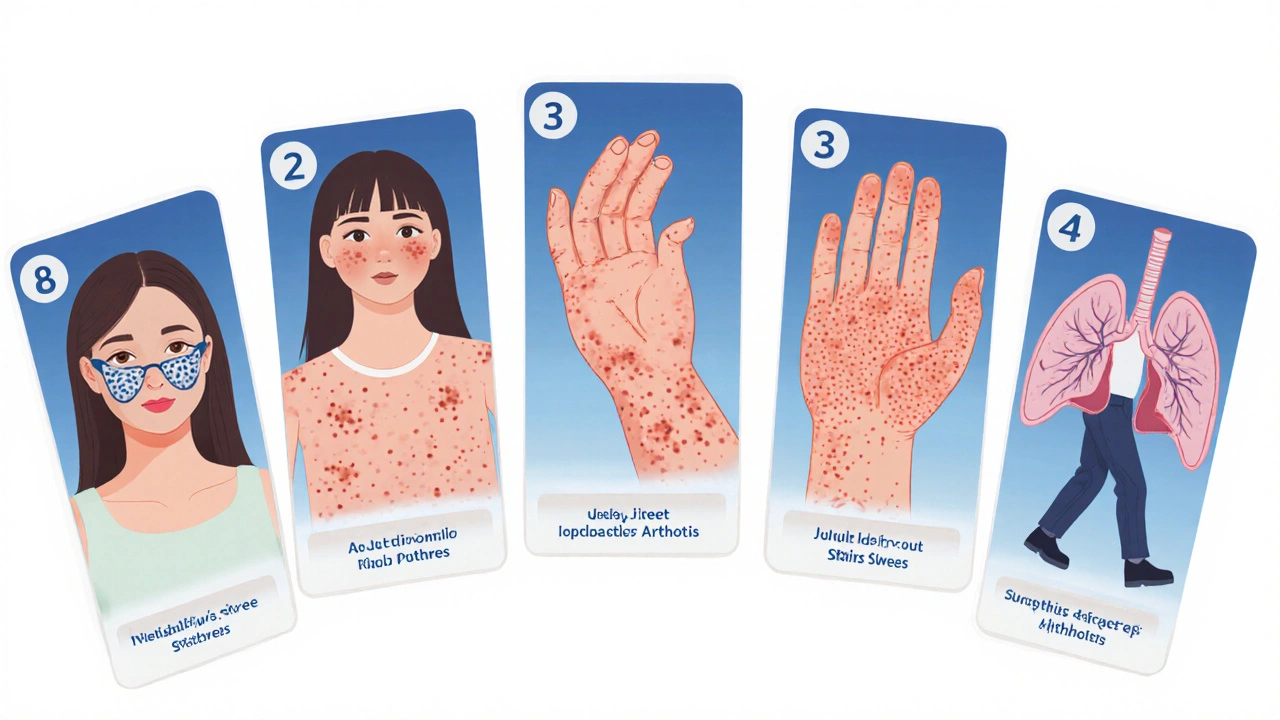Autoimmune Fever Patterns Quiz
Understanding how fever presents in autoimmune diseases can help identify potential conditions and guide treatment decisions. Test your knowledge below!
Ever wonder why a simple rise in temperature can be a clue to a deeper immune problem? In many autoimmune disorders, fever isn’t just a side effect - it’s a signal that the body’s defense system is firing on all cylinders, often in the wrong direction. Understanding this link helps you spot red flags, ask the right questions, and work with your doctor on smarter treatment choices.
What exactly is Fever?
When your temperature climbs above normal, Fever is a regulated rise in body temperature driven by the hypothalamus in response to pyrogens. Pyrogens can be external, like bacterial toxins, or internal, such as cytokines released during inflammation. The hypothalamus (the brain’s thermostat) reacts by releasing Prostaglandin E2 a lipid compound that raises the set‑point temperature, causing you to feel hot, sweat, and often experience chills.
Fever isn’t merely a symptom; it’s an active part of the immune response. By warming the body, it creates an environment less friendly to many pathogens and ramps up the activity of white blood cells.
Autoimmune diseases - a quick refresher
Autoimmune disease a condition where the immune system mistakenly attacks the body’s own tissues occurs when tolerance mechanisms fail. Instead of defending against invaders, immune cells unleash a barrage of inflammatory signals that can damage joints, skin, organs, and, crucially for our topic, trigger fever.
The culprits behind this misdirected attack are often Cytokines signaling proteins that coordinate inflammation such as interleukin‑1 (IL‑1), interleukin‑6 (IL‑6), and tumor necrosis factor‑alpha (TNF‑α). When these cytokines surge, the brain receives a “heat‑up” message, leading to fever.
Why fever shows up in autoimmunity
In healthy immunity, fever is a short‑lived response to a clear threat. In many autoimmune diseases, the inflammatory loop becomes chronic. Here’s how it works:
- Autoimmune activation releases IL‑1 a potent pyrogen that acts directly on the hypothalamus and IL‑6.
- These cytokines stimulate the liver to produce acute‑phase reactants proteins like C‑reactive protein (CRP) and ferritin that rise during inflammation.
- The hypothalamus, sensing the elevated cytokine levels, releases Prostaglandin E2, nudging the body’s thermostat upward.
- The result is a fever that can be intermittent, persistent, or spike dramatically during disease flares.
This mechanism explains why fever often mirrors disease activity: when the immune system ramps up, the temperature follows.

Autoimmune conditions that commonly feature fever
Not every autoimmune disease gives you a fever, but several do, and each has a characteristic pattern. Below is a quick reference to help you match symptoms to conditions.
| Disease | Typical Fever Pattern | Underlying Mechanism | Key Clinical Clues |
|---|---|---|---|
| Systemic Lupus Erythematosus (SLE) | Low‑grade, often linked to flares | Immune complex deposition → cytokine surge | Butterfly rash, joint pain, kidney involvement |
| Rheumatoid Arthritis (RA) | Morning spikes, may accompany joint swelling | Synovial inflammation → IL‑6, TNF‑α release | Symmetrical hand/foot joint pain, rheumatoid factor |
| Adult‑Onset Still’s Disease | High, quotidian spikes (often 39‑40°C) | IL‑1 and IL‑18 driven cytokine storm | Salmon‑pink rash, extreme fatigue, very high ferritin |
| Juvenile Idiopathic Arthritis (JIA) | Intermittent spikes, especially during disease flare | Joint‑derived cytokines (IL‑6) spill into circulation | Persistent limp, joint swelling in children |
| Vasculitis (e.g., ANCA‑associated) | Fever often precedes organ‑specific symptoms | Endothelial damage triggers systemic cytokine release | Skin purpura, renal impairment, respiratory symptoms |
| Sarcoidosis | Low‑grade, may be chronic | Granuloma formation → IL‑2, interferon‑γ | Lung nodules, skin lesions, elevated ACE levels |
Notice the overlap: many of these diseases share IL‑6 and TNF‑α as fever drivers. That’s why targeted biologic therapies can sometimes calm both joint pain and fever at the same time.
Diagnostic work‑up - separating fever of autoimmunity from infection
When fever appears, doctors first rule out infection because untreated infections can be life‑threatening. Here’s a streamlined approach you might see in a clinic:
- Detailed history: recent sick contacts, medication changes, disease flare patterns.
- Physical exam: look for rash, joint swelling, organomegaly, or signs of infection (e.g., lung crackles).
- Basic labs: CBC, CRP, ESR. A markedly high CRP with normal white count can hint at sterile inflammation.
- Autoimmune panels: ANA, RF, anti‑CCP, specific antibodies (e.g., anti‑dsDNA for SLE).
- Ferritin: especially useful in Still’s disease where levels can exceed 1000ng/mL.
- If labs are inconclusive, imaging (Chest X‑ray, Ultrasound) and cultures are ordered to definitively exclude infection.
When all infection work‑ups return negative but inflammatory markers stay high, clinicians label the situation as "Fever of Unknown Origin" (FUO) linked to autoimmunity and start disease‑specific treatment.
Managing fever in autoimmune disease
Therapy targets two fronts: the underlying immune dysregulation and the symptom (fever) itself.
- Antipyretics: Over‑the‑counter acetaminophen or ibuprofen can bring down temperature quickly. NSAIDs non‑steroidal anti‑inflammatory drugs that also reduce prostaglandin production are a common first line.
- Corticosteroids potent anti‑inflammatory drugs that suppress cytokine production: Low‑dose prednisone can curb both fever and joint inflammation during a flare.
- Biologic agents targeted therapies that block specific cytokines like IL‑1 (anakinra) or IL‑6 (tocilizumab). These are especially valuable in Still’s disease or refractory RA where fever is a dominant symptom.
- Disease‑modifying antirheumatic drugs (DMARDs) such as methotrexate or hydroxychloroquine help keep the immune system in check long‑term, reducing the frequency of fever spikes.
Remember, never rely solely on antipyretics to mask fever if an infection is possible. Masking can delay diagnosis and worsen outcomes.
Red flags - when to call your doctor ASAP
If you notice any of these alongside a fever, seek medical attention promptly:
- Fever > 39.5°C (103°F) lasting more than 48hours.
- Sudden onset of severe headache, neck stiffness, or visual changes.
- Rapidly worsening joint swelling or new organ pain (chest, abdomen).
- Confusion, difficulty breathing, or a rash that spreads quickly.
These signs may indicate infection, vasculitis, or organ involvement that needs urgent treatment.
Key Takeaways
- Fever is a regulated immune response driven by cytokines like IL‑1, IL‑6, and TNF‑α.
- Autoimmune diseases can trigger fever through chronic cytokine production.
- Conditions such as SLE, RA, Still’s disease, JIA, vasculitis, and sarcoidosis often feature characteristic fever patterns.
- Diagnostic work‑up focuses on ruling out infection first, then measuring inflammatory markers and disease‑specific antibodies.
- Treatment combines antipyretics, steroids, NSAIDs, and disease‑targeted biologics to control both fever and the underlying immune activity.
Frequently Asked Questions
Can a fever be the first sign of an autoimmune disease?
Yes. In many patients, especially with diseases like Still’s disease or early systemic lupus, an unexplained fever may appear months before joint pain or rash becomes noticeable.
How do doctors differentiate fever caused by autoimmunity from a simple infection?
They start with a thorough history and physical exam, then order labs such as CBC, CRP, ESR, and cultures. A high inflammatory marker profile with a normal white count, plus disease‑specific antibodies, points toward an autoimmune source. Imaging or targeted cultures are used when infection remains a concern.
Is it safe to take ibuprofen every time I have a fever flare?
Occasional use is generally fine, but chronic reliance can harm kidneys or upset stomach, especially if you’re also on steroids or methotrexate. Talk to your rheumatologist about a comprehensive plan that balances antipyretics with disease‑modifying therapy.
Do biologic drugs actually lower fever?
Targeted biologics such as anakinra (IL‑1 blocker) or tocilizumab (IL‑6 blocker) often reduce fever dramatically because they cut off the cytokine signals that drive the hypothalamic thermostat.
When should I consider emergency care for fever linked to an autoimmune condition?
Seek emergency help if the fever exceeds 39.5°C (103°F) and is accompanied by severe headache, stiff neck, chest pain, shortness of breath, sudden confusion, or a rapidly spreading rash. These signs may indicate infection, meningitis, or organ involvement that needs immediate treatment.


Leonard Greenhall
October 7, 2025 AT 18:10Cytokine‑driven fever is a classic immunologic response, yet the description of prostaglandin pathways omits the role of COX‑2 induction.
Abigail Brown
October 10, 2025 AT 00:33Reading about the fever patterns really makes you appreciate how the body’s thermostat can betray us when autoimmunity hijacks it. It's fascinating that a simple temperature spike can be a diagnostic breadcrumb leading straight to Still's disease or SLE. When you match the cytokine storm to the clinical picture, treatment decisions become far more precise. I love how the article highlights both the science and the personal impact of those fever spikes on daily life. Keep the optimism flowing-understanding these mechanisms empowers patients to advocate for the right therapies.
Crystal Slininger
October 12, 2025 AT 06:56From a mechanistic standpoint, the IL‑1β/IL‑18 axis functions as a master regulator of thermogenic signaling via the hypothalamic preoptic area, engaging the NF‑κB cascade and upregulating COX‑2 transcription. In Still's disease, the downstream amplification loop involves S100 proteins and HMGB1, which act as damage‑associated molecular patterns (DAMPs) to perpetuate a cytokine storm. Moreover, the acute‑phase reactant ferritin serves not merely as a biomarker but as a contributor to oxidative stress, further destabilizing the set‑point. These molecular interplays underscore why IL‑1 blockade (anakinra) yields rapid defervescence, whereas broader immunosuppression may lag. The overlapping IL‑6 and TNF‑α pathways in SLE and RA explain the shared febrile phenotypes despite divergent clinical manifestations.
Sumeet Kumar
October 14, 2025 AT 13:20Fever can feel like an unwelcome alarm, but recognizing its pattern really helps in tracking disease activity. When the spikes line up with joint pain or a rash, it’s a clear signal to adjust treatment before things get worse. Staying on top of labs like CRP and ferritin adds an objective layer to that intuition. It’s all about listening to the body’s subtle cues and working with your doc to keep the fire under control.
Maribeth Cory
October 16, 2025 AT 19:43Exactly-think of fever as a vital sign that mirrors the internal battle. By educating patients on what a “high‑quotidian” spike means, we empower them to report flares early, which can prevent unnecessary hospitalizations. A collaborative care plan that includes scheduled labs and symptom diaries makes the management proactive rather than reactive.
andrea mascarenas
October 19, 2025 AT 02:06Great overview; just a quick tip: keep an eye on punctuation around bullet lists to maintain readability.
Vince D
October 21, 2025 AT 08:30Short and sweet-knowing the fever pattern really narrows down the differential.
Camille Ramsey
October 23, 2025 AT 14:53Honestly, the article skims over the IL‑1 pathway like it’s optional reading; a decent piece should spell out that anakinra targets the exact cytokine driving those 40°C spikes.
Scott Swanson
October 25, 2025 AT 21:16Oh sure, because everyone has a PhD in immunology and can instantly spot a missing IL‑1 reference, right?
Karen Gizelle
October 28, 2025 AT 03:40While it’s important to share scientific details, we must never forget the human side-patients dealing with relentless fevers need compassionate communication, not just a list of cytokines.
Stephanie Watkins
October 30, 2025 AT 10:03Absolutely agree; framing the information with empathy helps patients feel seen, and it also encourages adherence to treatment plans.
Zachary Endres
November 1, 2025 AT 16:26The dramatic highs of Still’s disease can feel like a roller‑coaster, but knowing the underlying IL‑1 surge can turn that ride into a controlled glide with the right biologic therapy.